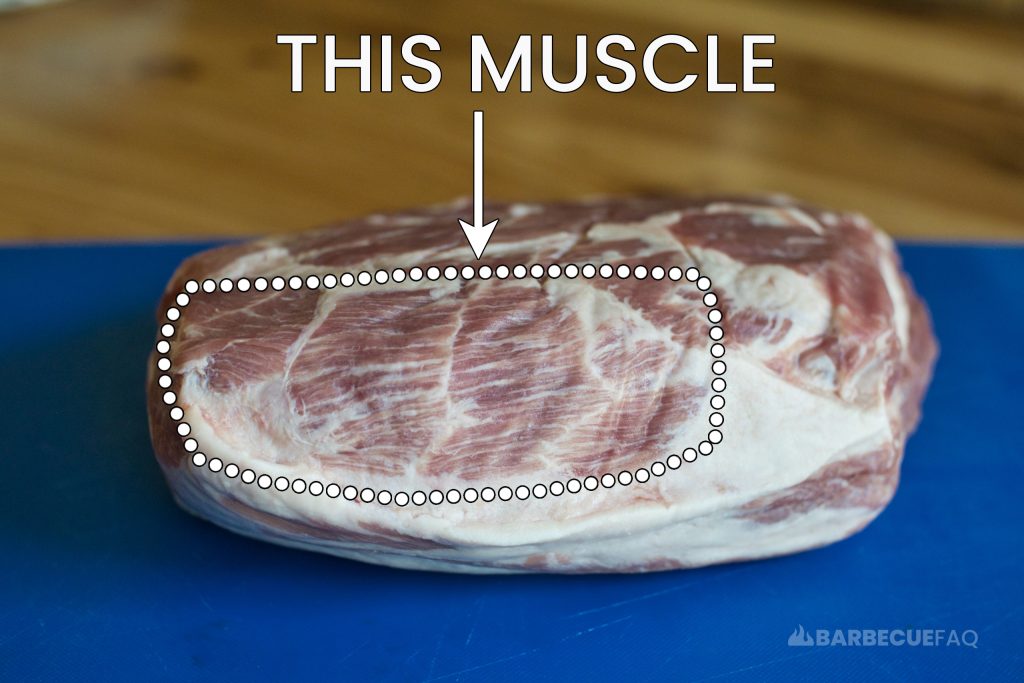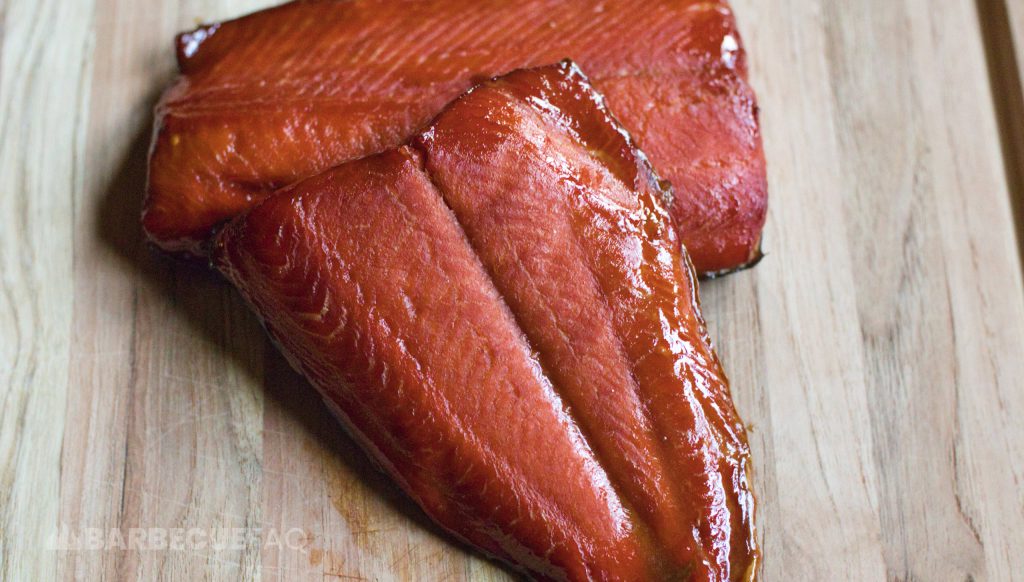Start With Any of These Cuts
(Click any Cut to Learn More)
1. Pork Butt
Pork butt is the best cut of meat to smoke for a beginner.
Period.

To start, it’s cheap – like wicked cheap; It’s typically $0.98-$1.98/lb.
In the grocery store, you also don’t have to spend time looking at the meat for things like:
- USDA “Grading”
- Marbling in specific parts of the meat
- Decent fat cap that you can trim
- Gouges in the meat
- Thickness of the meat
Where-as with Brisket, all of these things matter and will affect how the meat smokes.
The only “things” to decide are:
- Weight (lbs)
- Bone-in or Boneless
A typical boneless pork butt in a grocery store will be 3-4 lbs – A typical bone-in pork butt will be 6-8 lbs.

As a beginner to smoking meat, buying a pork butt that’s bone-in can be useful as an indicator of doneness.
When the meat is tender, the bone will cleanly and easily pull away from the bone – but is NOT necessary at all.
You also don’t have to worry about overcooking the meat because you’re pulling everything together anyway. If it’s dry, you just add some liquid or a sauce and you’re good.

Over time you might even consider separating the “money muscle.”
It sits on the opposite end of the blade bone and forms a cylinder (2-3 inches thick) of meat.
It is what most would consider the best muscle on the entire pig and is basically a better pork tenderloin because of the fat.

2. Beef Ribs (Dinos and Back Ribs)
Plate Short Ribs (Dino Ribs) are the EASIEST cut of meat to smoke – like truly near impossible to mess up.
You don’t have to:
- Trim literally anything
- Take off any membranes
- Worry about over-seasoning
- Worry about overcooking
- You can smoke hot and fast
BUT, they’re also one of the most expensive cuts on the entire cow; If price was a non-issue, I’d tell beginners to smoke beef plate ribs first.

They have so much intramuscular fat that they can’t dry out. The muscle being targeted is also supremely tender (the seratis ventralis).
You also want to cook them until they’re basically fall off the bone, so overcooking isn’t an issue.
I will say though, with Dino ribs, someone could take 1 bite and likely be satisfied – which is both good and bad.
If Dino Ribs are Too Expensive for You, Buy Back Ribs
Beef back ribs are quite literally ribeye meat on a bone.
Yet, they get no love.

Here’s what I mean too:
- A typical prime ribeye steak is like $15-20/lb.
- A rack of beef back ribs is the same cut of meat – only $4-5/lb
So it’s just cheap ribeye meat, on a bone.
There isn’t a ton of meat between the bones because butchers want to make money with Ribeye steaks, but the meat is still delicious and cheap.
3. Whole Chicken or Any Dark Meat Cut
Whether it’s a Whole bird or thighs, drums, or leg quarters, Chicken is fairly cheap and pretty hard to mess up.

Even with whole chicken, the only thing to pay attention to is the internal temperature of the breast and that’s it.
Same with pork butt, there’s no grading to consider and all you really have to think about is what your family likes to eat.

One of the biggest issues that people tend to run into when smoking chicken is rubbery skin; However this problem is easily solved:
- Spatchcock the chicken
- Pat dry the skin
- Salt overnight with kosher salt
- Use olive oil as a binder
- Smoke hot and fast (325F+)
Chicken is pretty easy to over-smoke and a little can go a long way. Smoke with maple or fruit woods like apple, cherry, or peach and go from there.
With thighs and drums you actually want to go to ~200F so the connective tissues can gelatinize and become fall off the bone tender without drying out.
With breast meat you can take the bird off at around 157-162F and allow carry over cooking to occur while still keeping the food safe.
4. Salmon is Popular for Fish
This is mainly because of it’s fat content – the fat will help to take on more smoke and keep the fish from drying out..
The typical process for smoking fish is 3-fold:
- Wet brine with salt + sugar
- Air dry the next day
- Smoke low and slow

I’m a big fan of maple with salmon, however Alder is the more traditional.
Salmon also doesn’t take long to smoke and the only thing to really watch for is albumin leakage.
5. If All Else Fails, Smoke a Chuck Roast
If brisket intimidates you OR the price is too high to screw up, start with Chuck Roast.
Chuck roast is typically $4-5 / lb – which is similar to brisket, only it weighs 2-3 lbs and not 8-20.

My only suggestion is to look for a chuck roast that’s USDA choice grade or higher.
Ungraded chuck roasts @ your grocery store can tend to be too lean and will dry out easily.
Apart from that, smoke @ 225-250F for 3-4 hours, wrap with foil until tender.
If you overcook the meat, well now you have chopped beef instead of slices.
A Quick Word About “Smoking” Meats as a Beginner
The number one mistake that every beginner falls victim to is the amount of smoke to use.
A lot of newbies think you need huge, white, billowing clouds of smoke. However, that couldn’t be further from the truth.
What you’re after is “thin blue smoke.” Essentially, thin blue smoke or “clean smoke” has more desirables of carbonyls (color components) and phenolics (aromatic compounds).

Thick white smoke or “dirty smoke” is the result of incomplete combustion and creates undesirables, namely wood creosote, which results in an acrid taste on your food.
While thick white smoke can have some applications, your goal initially should be thin blue smoke.





